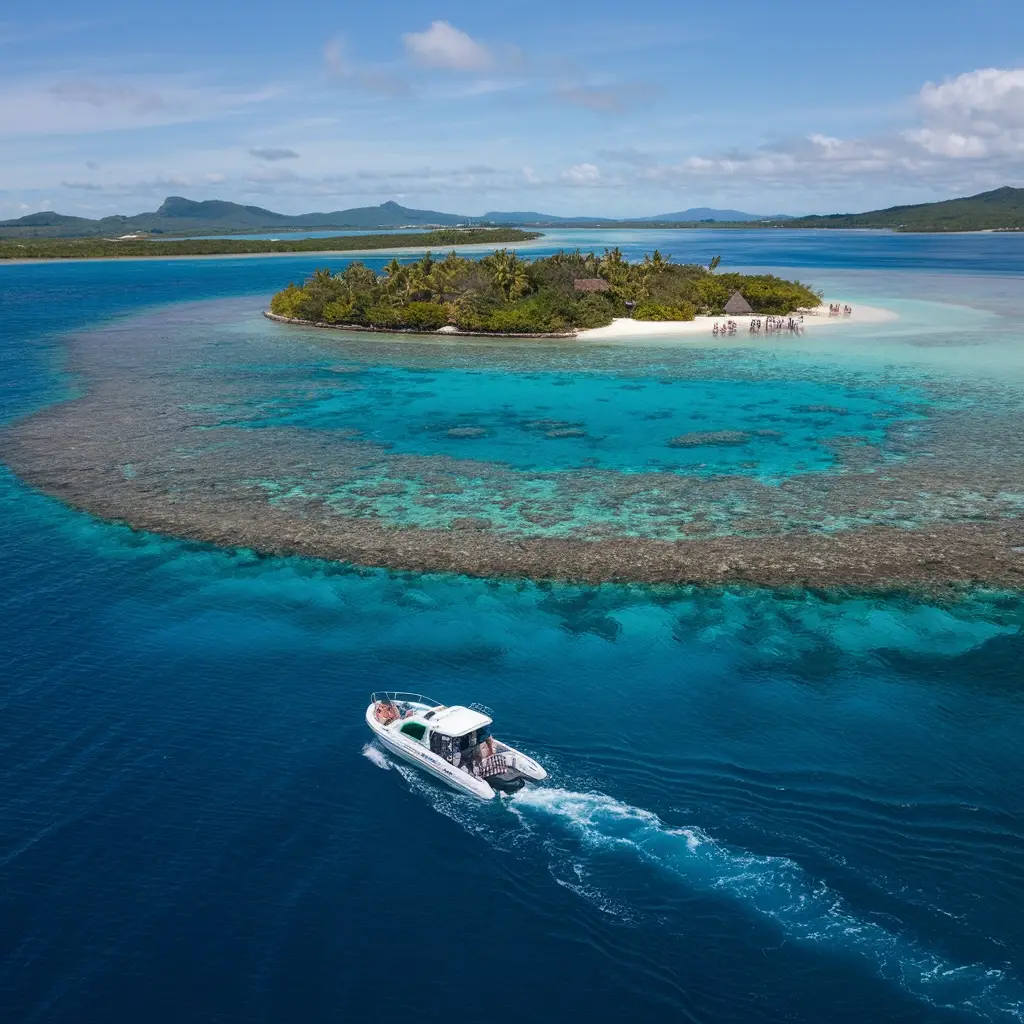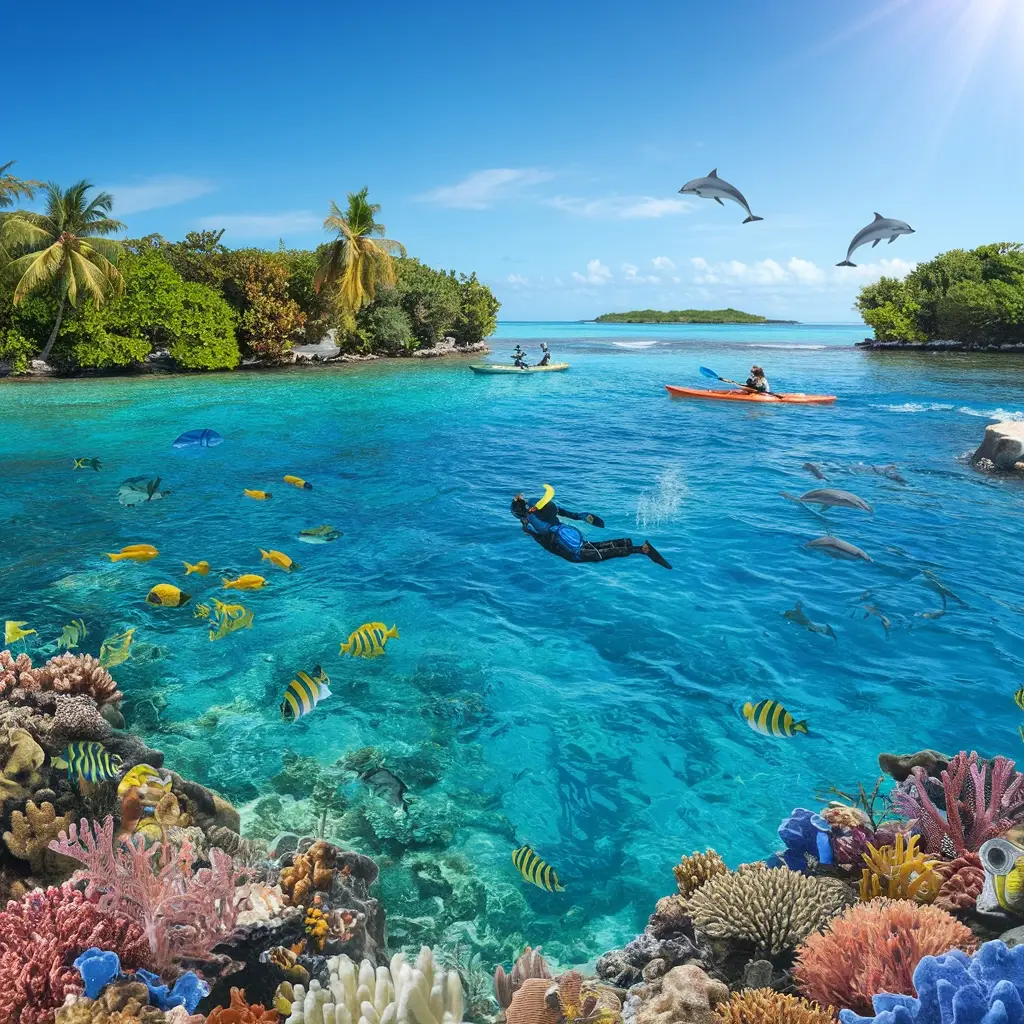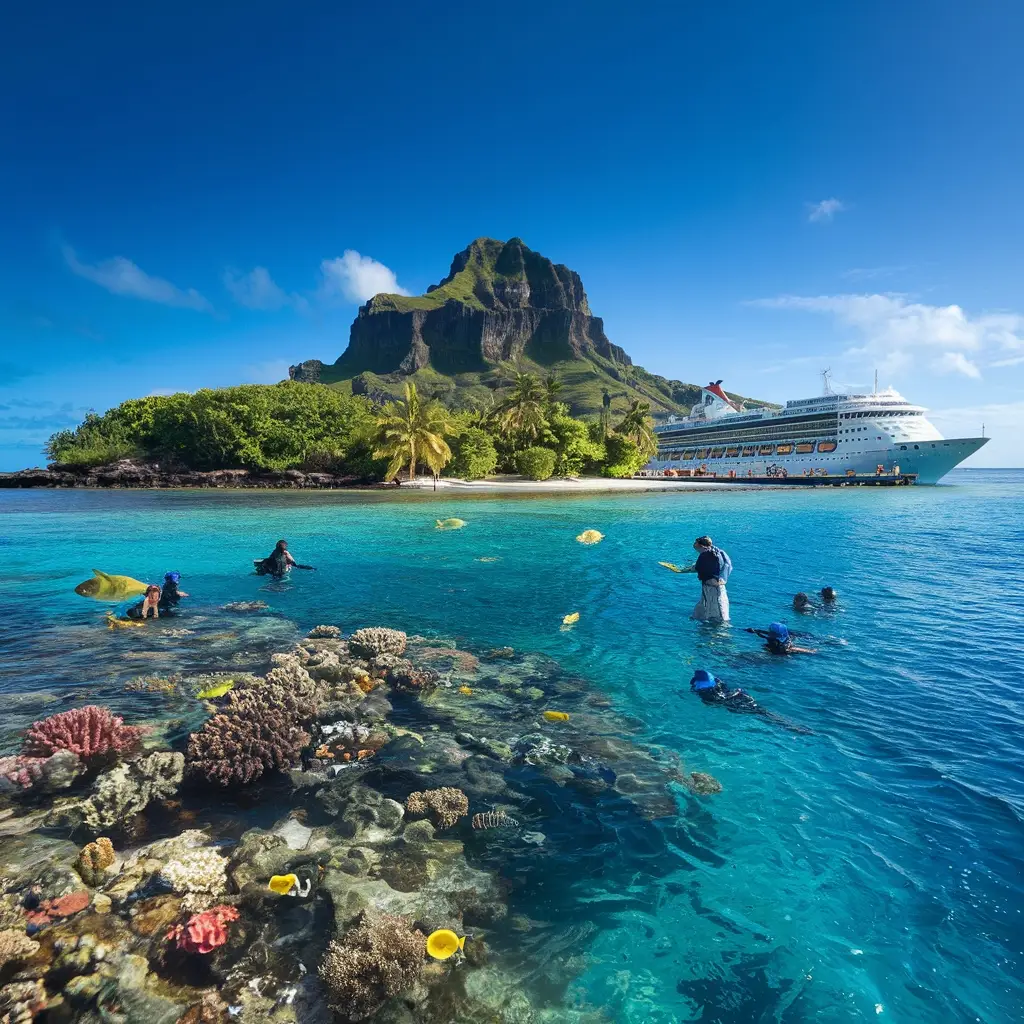Conflict Islands Cruise Ship Port Guide
Your ship will drop anchor offshore at the Conflict Islands, with tender boats running from 7-8 AM for a quick 15-minute zip to the floating pier.
For other Papua New Guinea Cruise destinations check out our Papua New Guinea Cruise Ports Guide page.
Don’t forget to pack reef-safe sunscreen, UPF clothing (trust me, that sun is brutal), and grab some Papua New Guinean Kina for souvenir shopping.
The snorkeling here is incredible – we’re talking 1,100 different fish species swimming around you!
Grab a drink at one of the palm-leaf bars, or check out the turtle conservation program if you’re feeling eco-friendly.
Just keep an eye on the weather – it can mess with the tender schedule.
Our full guide has all the nitty-gritty details from mobility issues to catching that last boat back before your ship leaves without you!
Map of Conflict Islands Cruise Ship Port
Arriving at the Lagoon: Tender Process & What to Expect

The Lagoon Arrival: Getting from Ship to Shore
Those beautiful blue waters around the Conflict Islands? They’re hiding coral reefs and shallow spots that keep the big cruise ships from pulling right up to the islands. Your ship will drop anchor about half a kilometer to a kilometer offshore, and you’ll need to hop on tender boats between 7-8 in the morning.
You’ll be joining a bunch of other passengers (usually between 100-200 folks) for a quick 10-15 minute boat ride to the floating pier. Just a heads up – they always let the organized excursion groups board first, so if you’re doing your own thing, you might wait a bit longer.
Weather can throw a wrench in the plans – if it gets too windy out there, they might delay the tender boats or even cancel them altogether.
Travel light! Just bring what you need for the day – sunscreen, water, maybe your snorkel stuff. And keep an eye on the time – the last boat back to the ship usually leaves 1-2 hours before your cruise is scheduled to depart. Miss it and, well… you know how that story ends!
Essential Packing Guide for Your Day Ashore
While paradise awaits at the Conflict Islands, packing smart will make your day ashore way more fun and a lot less sweaty in this far-flung tropical spot.
Must-haves? Reef-safe SPF 50+ sunscreen (the sun is brutal here!), a big floppy hat, and UPF clothes to keep from turning into a lobster. Bring your own snorkel gear to save some cash, plus a waterproof bag to keep your stuff dry.
Cash-wise, grab some Papua New Guinean Kina for shopping, though Australian dollars in small bills can work in a pinch. Maybe toss in some school supplies if you want to make island kids’ day, and remember to dress on the modest side when checking out local villages.
Waterproof phone case? Absolute game-changer for those underwater shots. And please pack biodegradable toiletries – you’re here to enjoy this pristine paradise, not mess it up!
Top Water Activities & Marine Life Encounters

The crystal-clear waters surrounding the Conflict Islands are home to some of the most mind-blowing marine adventures you’ll find anywhere. We’re talking over 1,100 different fish species and 400 types of coral just waiting for you to discover them.
Snorkeling here is ridiculously good – just walk right off Panasesa’s beaches and you’re instantly swimming above vibrant coral drop-offs. If you’re PADI-certified, you’ve got to check out the diving spots where manta rays migrate and reef sharks cruise by.
Not feeling that adventurous? No worries. Grab a kayak and paddle through the electric-blue lagoon, where you might spot baby turtles popping up to say hello. Or hop aboard the Undersea Explorer, our glass-bottom boat, to catch dolphins playing and see amazing deep-wall ecosystems while staying completely dry.
See what’s on offer from the Port of Kiriwina Island (Trobriand Islands) for a different Papua New Guinea Cruise destination.
Dining & Refreshment Options on the Islands
Feeling hungry after exploring? You’ll find plenty of laid-back eating spots dotted around the Conflict Islands – think rustic palm-leaf bars and breezy kiosks rather than stuffy restaurants.
The central kitchen dishes up tasty local treats like fresh-caught grilled fish, chicken satay skewers, and crispy sweet potato chips. Got a sweet tooth? Hit up the dessert bar for juicy pineapple chunks and chocolate vegan brownies. When you need to cool off, grab a frozen tropical slushie at the Coconut Bar or just stick with filtered rainwater.
Just remember to buy your food vouchers with cash – they take Australian dollars or PNG Kina. If you’re vegetarian, the menu’s a bit limited, so chuck some extra snacks in your bag if you’ve got specific dietary needs.
Conservation Efforts & How Visitors Can Contribute

Conservation Efforts & How You Can Pitch In
The Conflict Islands aren’t just about gorgeous beaches and blue waters – they’re home to one of the South Pacific’s most impressive conservation programs. Check out their turtle protection work that’s saved over 2,300 nests since 2017. Want to get involved? Join a guided tour and learn how they relocate turtle nests to safer spots.
Roll up your sleeves and help with beach cleanups, try your hand at coral planting, or snap photos of manta rays for scientific research. The locals are in on it too – the Solwara Meri Ranger Program trains island residents in conservation skills. Remember, all the eco-tours here have strict “look but don’t touch” policies, and you’ll need to wear reef-safe sunscreen to protect the amazing underwater world you’ve come to see.
Practical Tips for Different Mobility Levels & Age Groups
Practical Tips for Different Mobility Levels & Age Groups
Protecting these gorgeous islands is crucial, but so is planning your trip based on how well you get around and your age.
Wheelchair users – heads up about the sand! It’s tricky to navigate, so consider grabbing portable beach wheelchairs. Seniors, take it easy by using the shaded rest spots and hopping on electric shuttles between main areas.
Got kids? You’ll love the supervised snorkel zones where floating devices are on the house. Everyone should pack water shoes – they’re lifesavers on those slippery rocks!
Match activities to how mobile you are: stuck with limited movement? Glass-bottom boats let you see all the underwater magic without getting wet. Decent mobility? Try shore snorkeling. Super active? Grab a paddleboard and go! No matter your situation, there’s a way for you to soak up these stunning islands.
Frequently Asked Questions
What’s the Wifi and Cell Signal Situation on the Islands?
Just so you know – there’s satellite WiFi at the clubhouse, but that’s it. Don’t expect your phone to work out here on these islands – they’re pretty much off the grid. We’ll all be doing that digital detox thing together while we’re out here!
Are There Any Safety Concerns Regarding Wildlife or Insects?
When you’re out there, you’ll run into sea critters like sharks and some venomous stuff hanging around the coral reefs. Best to slap on some protective footwear while snorkeling. Watch out for those pesky mosquitoes too – they might be carrying dengue or Zika. Just make sure you’ve got repellent on, particularly if you’re wandering through bushy areas.
Can I Use Drones for Photography on the Islands?
Heads up – drones are a no-go on the islands. Wildlife protection rules don’t allow them since they can spook nesting birds and mess with the delicate marine ecosystems. The local conservation folks keep a pretty tight lid on aerial photography for this reason. You’re better off leaving your drone at home for this trip.
What Currency Should I Bring for Shopping With Local Vendors?
For shopping with local vendors, bring Australian dollars (AUD) – that’s your best bet. Some places take PNG Kina too, but honestly, most of the time you’ll be using a voucher system that you buy with cash. Don’t count on credit cards working here – they just don’t. Make sure you hit the ATM before you go!
Does the Island Have Religious Services or Sacred Sites?
While there aren’t any regular church services or formal worship, the islands do have some pretty special indigenous sacred sites. Places like Kasiawa Cave and the Mikoeatira boulder are considered holy ground. If you want to visit, just know you’ll need to participate in some respectful ritual prep first – the locals take these spots seriously as places where spiritual beings hang out.
Thinking about something different? Check out the cruises leaving from Alotau Cruise Ship Port.
